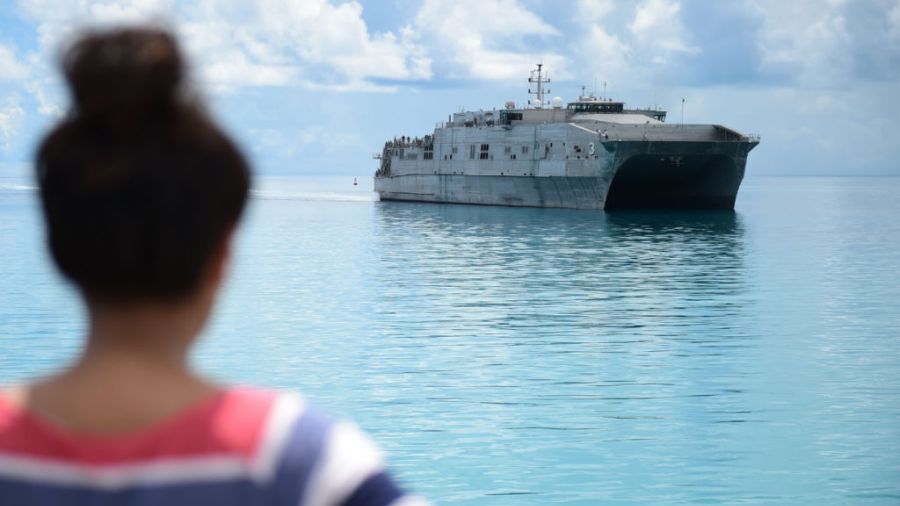America’S Strategy in Oceania: Time for a Better Approach
The Pacific island nation of Kiribati has no military, a population only one-sixth the size of Washington, D.C.’s, and a gross domestic product of less than $200 million. Despite that, it is the site of growing geopolitical competition. Lured by the promise of significant development aid, Kiribati terminated its diplomatic recognition of Taiwan two years ago and established relations with Beijing. Since then, the Chinese government announced plans to upgrade an airstrip and bridge on Kiribati’s remote island of Kanton, which lies astride the sea lanes connecting Hawaii with Australia and New Zealand. Such Chinese government activism in Oceania has generated alarm among America’s political and military leaders, both in Washington and at Indo-Pacific Command in Hawaii.
Despite the Biden administration’s growing interest in Oceania, the U.S. government does not have a comprehensive strategy for the Pacific island nations, and time is running out. As Darshana Baruah argues, “Washington’s current Indo-Pacific strategy lacks an understanding of small island nations and littoral states, and how the changing dynamics between these small states and their security providers is shaping the overall regional security environment.” China has moved in earnest to engage with Oceania, filling a strategic gap, while the United States is vying to get a toehold there, having largely ignored it for decades.
Although speed is of the essence, it will take considerable time and patience to build trusting relationships in the Pacific islands in order to compete against Beijing in the long run. To develop an effective strategy for engaging with those countries, the United States should strive to better understand and adapt to the unique characteristics of each of them. The United States can leverage an important asset in that endeavor: American allies like Australia and New Zealand have deep knowledge of the islands, decades of experience engaging with them, and established relationships with the islands’ policymakers and peoples. U.S. officials could seek guidance from their counterparts in Australia and New Zealand and use it to inform the Defense Department’s strategic approach in Oceania.
The Pacific Island Countries
The Pacific island countries have small populations. Kiribati only has 121,000 people, even though the country stretches 2,400 miles from east to west, and only one of the island nations — Papua New Guinea — has a population over one million. These nations rely heavily on fishing, subsistence agriculture, tourism, and foreign aid. Papua New Guinea, the Solomon Islands, and New Caledonia also have active mining sectors. Papua New Guinea, with its 9 million people, has a gross domestic product of around $25 billion, but in per capita terms that is less than $3,000. Many of the other Pacific island nations have gross domestic products less than $1 billion, and six of them are among the 10 most aid-dependent countries in the world.
Only three of the Pacific island countries — Fiji, Papua New Guinea, and Tonga — have militaries. Fiji has the largest, with 9,500 active-duty and reserve forces. Papua New Guinea’s military comprises 3,600 personnel, and Tonga’s has only 450. The Federated States of Micronesia, the Marshall Islands, and Palau are all in free association with the United States. Both the Cook Islands and Niue are similarly associated with New Zealand.
Chinese Engagement in Oceania
Today, China is the third largest aid donor to Oceania, behind Australia and New Zealand. Engagement in Oceania figures into Chinese policymakers’ strategic thinking in at least two ways: as a means of furthering the one-China policy and as part of an effort to challenge the United States for primacy in East Asia and the Pacific.
Taipei and Beijing compete for diplomatic recognition by the small Pacific island countries. Of the 15 countries around the world that have full diplomatic relations with Taiwan, four of them are in Oceania — the Republic of the Marshall Islands, Nauru, Tuvalu, and Palau. But Kiribati and the Solomon Islands shifted their support away in 2019. The competition for recognition is waged with promises of meaningful development aid. For example, China donated $11.3 million for rural development to the Solomon Islands following its recognition of Beijing.
Beijing has signed Belt and Road Initiative agreements with 10 Pacific island countries. Similarly, China has ramped up its development assistance in the region, providing roughly $1.5 billion in grants and loans from 2006 through 2017. In April 2018 and in October 2019, reports emerged of China negotiating to establish naval bases in Vanuatu and the Solomon Islands, respectively. Neither of the negotiations succeeded.
American Engagement in Oceania
Shortly after the Trump administration published the 2017 National Security Strategy, there followed a notable uptick in focus on the Pacific island nations, not only in Washington but also in Wellington, Canberra, and Tokyo. Having labelled China a “revisionist power” that was expanding its influence in the Indo-Pacific region, Trump administration officials — and American allies — began to acknowledge that the Pacific island nations play a critical geostrategic role. The loudest voices expressing that point were not in Washington but in Wellington and Canberra. New Zealand’s government announced its “Pacific Reset,” which was followed by Australia’s “Pacific Step-Up.” Both countries expanded, deepened, and diversified their spending and presence in the Pacific island nations, and they also advocated for greater attention to those nations by Washington.
The Trump administration took three important steps in response. First, it pressed for quick action on further funding for the three freely associated states in the Pacific. But the COVID-19 pandemic and the American electoral cycle stymied successful conclusion of those funding negotiations. Second, the administration created a director for Oceania position on the National Security Council staff that focused on the Pacific island nations, Australia, New Zealand, and the Antarctic. Third, it announced the “Pacific Pledge,” which entailed more than $300 million in new spending, delivered mainly through the U.S. Agency for International Development in 2019 and 2020.
The Biden administration continues to strengthen links with the Pacific island countries by emphasizing steps to address climate change and by providing COVID-19 vaccines to them. The focus on the climate crisis aligns with the Pacific Islands Forum’s Boe Declaration, which named climate change as an existential threat to those island nations.
The U.S. Congress has also acted to strengthen engagement in Oceania. Members of the House of Representatives formed a Pacific Caucus in 2019, and several of its members authored the Boosting Long-term U.S. Engagement in the Pacific Act, which is also referred to as the BLUE Pacific Act. In May 2021, in a new Congress, the act’s sponsors re-introduced the legislation. In June, the Senate passed the Innovation and Competition Act of 2021, which includes language drawn from the BLUE Pacific Act and recognizes the importance of the Pacific island countries to American efforts to contest Beijing’s revisionist actions. In particular, the act calls for creating an “Oceania Roadmap” that would outline how the United States can deepen its engagement with island nations in the region and that would include analysis of opportunities to cooperate with Australia, New Zealand, and Japan in that regard.
Learning from Allies
The Department of Defense should begin fleshing out its strategy for the Pacific island countries. Elucidating this strategy should include identifying specific, measurable objectives and relevant outcome indicators, as well as available resources. Most importantly, it should involve consultation with key allies to better understand their experience, lessons, and efforts already underway. This process can be helpful not only for the Defense Department’s learning purposes but also for combined strategizing.
Australia has led several multi-year whole-of-government missions in Timor-Leste, the Solomon Islands, and Papua New Guinea. New Zealand has also been an active participant in those missions. For example, Australia and New Zealand collaborated in the 1990s to facilitate a peace deal that ended the separatist conflict on the island of Bougainville in Papua New Guinea. It led to local autonomy for the Bougainvilleans and a non-binding referendum in 2019, in which 98 percent of voters backed independence.
A characteristic of Australian-led interventions has been an evolving whole-of-government approach, which has included contributions by the Australian Defence Force, Australian Federal Police, Department of Foreign Affairs and Trade, and AusAid. This holistic approach, characterized by doing more with less, is highly appropriate for engaging with Pacific island countries. Both Australia and New Zealand benefit from having diplomatic missions to most of those nations, which provide them with a high level of local awareness and access.
Research shows that America’s relative influence in the wider region is waning but that its partners want the United States to remain engaged because of its influence and resources. Australia and New Zealand have rich relationships with the Pacific island nations that are worth exploring, especially their light-touch, soft power-oriented, and inclusive planning approaches.
A key element of Australia’s regional outreach is the “Pacific Maritime Security Program.” Between 1987 and 1997, under its former name “the Pacific Patrol Boat Program,” it provided patrol boats to 12 countries to improve their maritime surveillance and fisheries protection capabilities. The countries participating in the program today — 12 Pacific island nations and Timor-Leste — will have their boats upgraded with the delivery of 21 Guardian-class Patrol Boats between 2018 and 2023. The program also includes an aerial surveillance component, which has generated additional requirements that the Australian Department of Defense may have difficulty fulfilling. This presents an opportunity for the U.S. Defense Department to collaborate with Australia to provide secure communications and other intelligence, surveillance, and reconnaissance capabilities to the Pacific island countries.
The United States has limited presence in the South Pacific, whereas Australia and New Zealand are ever-present. Defense Department planners are used to taking the lead in security cooperation efforts around the world, but due to the deeper relationships that its allies have with the Pacific island nations, this is an area where the department should consider taking a backseat to allies while supporting mutually beneficial security cooperation initiatives.
A Long-Term Strategy for Oceania
What best practices and lessons for the U.S. government are crucial to building a long-term strategy for engaging the Pacific island countries? What approaches will likely work to enable combined planning with allies?
First, Defense Department security cooperation planners and implementers should seek guidance from allies with deeper experience in these countries. They could draw heavily upon allies’ extensive experiences and presence in the region, especially in the Solomon Islands, Timor-Leste, Papua New Guinea, and Fiji.
Second, American officials should ensure they are listening to their Pacific island counterparts and take care not to assume that all countries have the exact same needs or desires for assistance. Working effectively in the region will demand planning on a longer time horizon — over periods longer than 10 years — even without guaranteed financial resource allocations. The U.S. Army’s new Task Force Oceania, stood up in 2020, is a mixed force of active-duty, reserve, and National Guard soldiers, and a good start to help set the stage for the building of long-term relationships.
Third, planners should include Pacific island nation officials in the security cooperation planning process from the beginning, rather than informing them about decisions already concluded.
Fourth, a multi-departmental, whole-of-government approach — rather than a military-military approach — could be pursued. Allies are not comfortable with Indo-Pacific Command’s focus on military aspects of security cooperation with the Pacific islands. This approach isn’t even feasible in countries that have national police forces but no military. Allies have suggested a need to expand the focus of the Multinational Working Group — which includes the “Five Eyes” allies plus France and Japan — to include select civilian agencies that focus on health security, institutional capacity building, resilience, humanitarian assistance and disaster response, and illegal fishing.
A vital part of the strategy that the U.S. government should consider would include a clear statement of its commitment to work together with allies in the region in a combined planning approach. This statement needs to come from senior-level leadership and then be strongly reinforced by mid-level officials. The Defense Department could move beyond deconfliction and coordination of activities with allies in Oceania to a combined planning and implementation approach. The United States does not need to be in the lead in these engagements. The Defense Department could consider taking a backseat where appropriate and playing a supporting role to allies’ initiatives. This approach would allow the United States and its allies to gain influence in the Pacific island countries and better compete with China.







